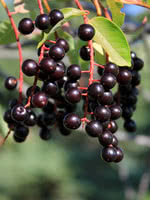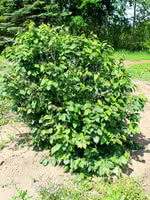Mon-Fri 9am - 5pm Mountain time
Beaked Hazelnut vs Western Chokecherry
Prunus virginiana var. demissa
Corylus cornuta
SOLD OUT
NOT AVAILABLE THIS SEASON - MIGHT RETURN
Western Chokecherry is a shrub or small tree commonly used for farmstead and field windbreaks.
It produces white flowers in the spring and edible dark purple fruit that matures between September and October. Its cherries are great for making for making jams, jellies or wine, but are not very palatable for raw eating.
Beaked Hazelnut is a multi-stemmed, deciduous shrub native to North America.
It features smooth, grey bark and edible nuts. Beaked Hazelnut prefers a rich sandy-clay loam but will grow on poorer sites, and can be used as an understory shrub.
Note: You want more than one hazelnut to improve yields.
Western Chokecherry Quick Facts
Beaked Hazelnut Quick Facts
Toxicity: toxic to horses, cattle, etc.)

